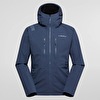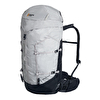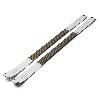Massimo Piras and his timeless love for ice climbing

 1 / 11
1 / 11 archivio Massimo Piras
archivio Massimo Piras
Massimo is no longer that youngster who climbed with ice axes that had wooden handles, but he is the best example of what I like to call "past progressive." Certainly not in its grammatical sense, but in its truest meaning, i.e. great experience accumulated over the years that intelligently illuminates the young, indicating new realms in which they can move. Such as dry tooling, a discipline that Massimo teaches at the Gervasutti School of Mountaineering at Turin. I ask him what he tries to transmit to those youngster who listen to his lectures: "Simply to observe" he replies with a smile, "Because carefully watching a smooth, beautiful ascent is the best way to learn how to climb and emulate an ascent. This holds true for ice climbing in particular, and even more for mixed climbing or dry tooling, where your body and ice axes need a particular degree of sensitivity in order to feel secure on the tiny tip of steel placed in the folds of the wall."
The calm that transpires from his actions and words never ceases, not even when he talks to me about his solo ascents. Massimo focuses my attention on an aspect he considers particularly important: not to confuse the two, i.e. climbing solo but with a harness and rope stuffed away in a rucksack in case of an emergency, and free solo. At times he has climbed alone because he couldn’t find other partners, often though his lone ascents were carried out consciously, to expand his spectrum of introspective knowledge and to compete with the mountain on equal terms. Ice and rock which, through the eyes of this gentle man, return to the harsh and beautiful state they were for climbers in the early days. "It’s very difficult to experience nowadays the exploration that took place twenty-five years ago. Perhaps it’s even impossible. In those years things were a constant challenge and we stole each others icefalls as soon as they formed. If I was asked whether an icefall was in condition, I’d give a vague answer, I never knew even if I was going to climb it. The sense of adventure, at least on ice where important drips have already been climbed, is long gone." Hence the shift in focus to rock and to drytooling.
Who better than Massimo can explain to me why people climb ice. What drives an alpinist to confront themselves on formations that are the very limit of delicateness and instability? "Because you enter the huge kingdom of what is here today and what might not be here tomorrow. Because climbing ice isn’t like going to the crag to climb rock that is always there and is always the same. And how can the purity of a vertical line of striking blue ice, that stands out from the rocks, not fuel the imagination of an alpinist?"
Edoardo thanks Mauro Marcolin and Wild Climb for the support and gear.
| Expo.Planetmountain | |
| Expo Wild Climb | |



 Copia link
Copia link









 See all photos
See all photos






















